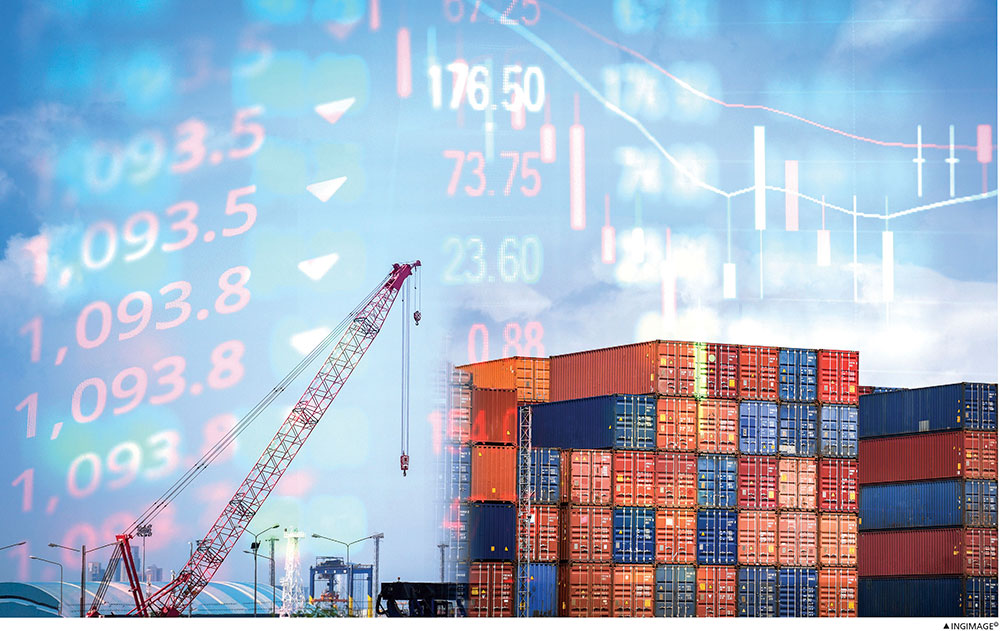A REVIVAL IN MOTION
Sri Lanka is repositioning itself as a resilient regional hub with exports leading the way

Sri Lanka is regaining its footing as a dynamic export hub in South Asia, as evidenced by its latest export earnings – US$ 4 billion in the first quarter of this year. This growth reflects a six percent jump over the previous year, which is an indication that the economy is showing signs of transitioning from crisis to competitive advantage.
In the meantime, a reshaping of the export landscape is taking place.
While traditional industries such as apparel, tea and coconut based products remain vital, Sri Lanka is carving a niche in knowledge services, value added food products and sustainable manufacturing.
A notable feature of the latest export performance is the growing prominence of services exports, particularly in the ICT and business process management (BPM) sector. This signals the emergence of a digital economy grounded in talent, innovation and global demand. The segment has a strong talent base, and is well positioned for expansion of digital platforms, AI services and fintech.
During the first quarter of 2025, apparel and textiles – the mainstay of Sri Lankan exports – grew 11.7 percent year on year. The food and beverage industry also posted strong growth with processed food exports surging, indicating the rise of an emerging market for value added agro-products.
Tea, coconut based products, activated carbon and spices and essential oils continued to perform solidly, reinforcing Sri Lanka’s reputation for high quality and ethically sourced natural products.
Investors would do well to note that these sectors also hold untapped potential for investments in value chain expansion, processing facilities and sustainable product innovation.
In the food processing and agricultural technology segments, there is a visible shift towards value added food exports, with investment potential in cold chains, R&D and premium product development.
From Ceylon Cinnamon and coconut based products, to organic fruits and vegetables, Sri Lanka’s agricultural exports are gaining traction in niche global markets.
Major export destinations have responded positively to Sri Lanka’s recovery story. The US – Sri Lanka’s largest single export market – absorbed a major portion of the island’s exports, followed by the UK. Meanwhile, markets such as Germany, France, Belgium and the Netherlands also saw remarkable increases. Trade with regional partners such as India and China is also expanding.

In the realm of sustainable manufacturing, apparel and coconut based product exporters are increasingly integrating environmental, social and governance (ESG) frameworks, creating scope for ethical investment partnerships.
Meanwhile, the demand for efficient digitised supply chains and warehousing infrastructure is growing as exports surge, placing logistics and trade facilitation at the forefront of export led growth.
One of Sri Lanka’s undeniable advantages is its strategic location, offering easy access to markets in South Asia, Southeast Asia, the Middle East and Africa. The Port of Colombo, one of the busiest in the region, serves as a transshipment hub connecting global supply chains.
However, more strategic policymaking is needed to leverage these geographical advantages.
The island is also no stranger to sustainable manufacturing and environmentally conscious practices, which makes it attractive for ethical brands.
Furthermore, Sri Lanka is globally recognised for its high quality natural rubber. Local producers are increasingly moving into value added segments such as solid tyres, medical gloves, sports equipment and automotive components, areas with consistent global demand.
The nation’s tourism product offers immense promise too. With a growing emphasis on wellness, ecotourism and heritage experiences, the industry offers investors long-term growth opportunities aligned with sustainable development goals.
However, challenges remain.
The Guardian recently noted that although Sri Lanka’s GDP is a mere 0.3 percent the size of the US economy, it could soon be facing a 44 percent tariff, despite being bailed out by the International Monetary Fund (IMF) two years ago and continuing to negotiate debt restructuring deals with its creditors.
If it remains as proposed, the tariff is expected to impact export income since a quarter of Sri Lanka’s exports end up in the US with garments accounting for up to 70 percent of that volume.
That said, there is a window of opportunity for Sri Lanka as other major markets pivot away from the United States. Given its current policy framework, access to key markets through FTAs and generalised scheme of preferences plus (GSP+) privileges, the country is ready to attract investments.
Looking ahead, the government has set an ambitious target to achieve export revenues totalling 18.2 billion dollars in 2025 and US$ 36 billion within the next five years.
Some of the key drivers of growth as the year unfolds are expected to be political stability along with strategies such as stringent anti-corruption measures, foreign direct investment (FDI) and streamlining export related approval processes under the government’s digital economy initiative.
Against this backdrop, the World Bank projects 3.5 percent economic growth for Sri Lanka in 2025, contingent on continuation of key reforms and favourable global trade dynamics.

